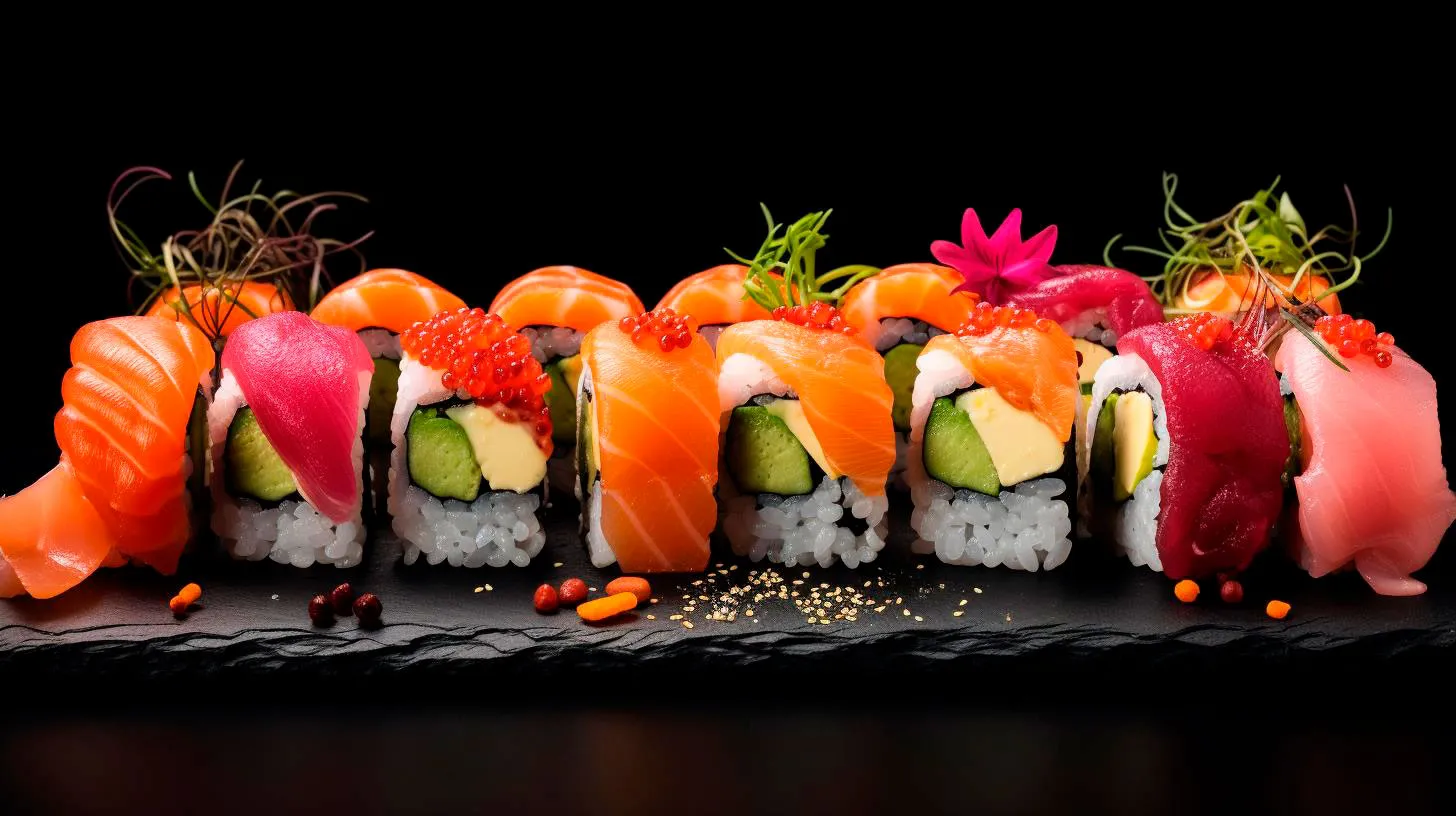The Art of Precision: Exploring the Intricate Tools Used by Sushi Chefs
In this article, we will delve into the fascinating world of sushi tools and explore the art of precision that sushi chefs embody.
The Knife: A Sushi Chef’s Most Important Tool
At the heart of every sushi chef’s toolkit is the knife. The iconic sushi knife, known as a yanagi, features a single-edged blade with a long, narrow shape. This design allows for precise slicing and carving of fish and other ingredients. The sharpness and balance of the knife enable the chef to achieve paper-thin cuts, essential for creating beautifully arranged sushi rolls and sashimi plates.
Key Takeaway: Sushi knives are crafted to perfection, allowing chefs to achieve the razor-thin cuts that give sushi its elegance and visual appeal.
It is essential to note that sushi knives require expert handling and maintenance. Sharpening the knife at a specific angle and using a whetstone are crucial steps in its upkeep. The meticulous care taken with the sushi knife reflects the commitment to precision that sushi chefs bring to their craft.
Bamboo Mat: The Versatile Sushi Rolling Tool
Bamboo mats, also known as makisu, are indispensable tools for sushi chefs. These flexible mats are traditionally made from bamboo strips woven together with cotton string. Chefs use them to create tightly rolled sushi rolls, known as maki. The bamboo mat provides structure and assists in applying the right pressure to keep the roll intact.
Key Takeaway: Bamboo mats are instrumental in creating perfectly rolled sushi and maki, showcasing the chef’s expertise in maintaining precise shape and texture.
Sushi chefs skillfully wrap the bamboo mat around a sheet of nori (seaweed) and layer it with sushi rice and various fillings. The mat is then gently rolled, applying even pressure to form a tightly wrapped roll. This technique ensures that the ingredients are well-distributed and held together securely, allowing for a visually appealing and delightful eating experience.
Rice Cooker: The Secret Behind Perfect Sushi Rice
Any sushi connoisseur will tell you that the quality of the sushi rice is the backbone of every sushi dish. A rice cooker, or suihanki, simplifies the process of achieving the perfect texture and consistency for sushi rice. By maintaining the ideal balance of moisture and temperature throughout the cooking process, the rice cooker enables chefs to consistently produce top-quality sushi rice.
Key Takeaway: Sushi rice cooked to perfection provides the foundation for an exceptional sushi experience, ensuring that each grain is plump, tender, and full of flavor.
Sushi chefs meticulously measure the ratio of rice to water and control the cooking process to achieve precise results. The high-quality sushi rice sets the stage for a harmonious fusion of flavors when combined with fresh fish and other ingredients.
Wasabi Grater: Enhancing Flavor and Presentation
Wasabi, the fiery green condiment typically served with sushi, can either be pre-mixed or freshly grated. Sushi chefs often prefer to grate wasabi root using a sharkskin grater, called oroshigane. The fine texture obtained from grating enhances the flavor and aroma of wasabi, providing a perfect accompaniment to sushi. Additionally, the shavings produced by the grater serve as a visually appealing garnish.
Key Takeaway: Freshly grated wasabi adds a unique kick to sushi and elevates the overall dining experience with its vibrant flavor and visual appeal.
By using an oroshigane, sushi chefs have greater control over the consistency of the grated wasabi, ensuring a balance between spiciness and aroma. This delicate touch demonstrates their dedication to fine-tuning every aspect of sushi preparation.
Sushi Mold: Creating Perfectly Shaped Nigiri
Nigiri, a classic form of sushi, consists of a small, hand-formed mound of sushi rice topped with various ingredients. Sushi molds, known as nigiri-mold or nigiri-su, assist chefs in creating uniformly shaped nigiri pieces with precision and efficiency.
Key Takeaway: Sushi molds enable chefs to create consistently sized, visually appealing nigiri pieces, showcasing their attention to detail and commitment to presentation.
With the help of a sushi mold, chefs can align and mold the rice into a compact shape, ensuring uniformity among nigiri pieces. This allows for a visually pleasing plating arrangement and enhances the overall dining experience for sushi enthusiasts around the world.
In conclusion, mastering the art of sushi requires not only culinary skills but also a deep understanding of the precision and tools involved. From the expertly crafted knife to the versatile bamboo mat, every tool in a sushi chef’s arsenal plays a crucial role in achieving impeccable flavor, texture, and visual presentation. The dedication and meticulousness exhibited by sushi chefs demonstrates why sushi is not just a meal; it is an art form.
Mastering the Craft: Unveiling the Secrets Behind Sushi Chefs and their Tools
The Essential Tools of a Sushi Chef
A sushi chef’s arsenal is incomplete without a set of specialized tools that aid them in crafting the perfect sushi. Let’s take a closer look at some of the most essential tools:
- Sushi Knife: Arguably the most important tool in a sushi chef’s collection, the sushi knife, or Yanagiba, is a long, single-edged blade specially designed to slice raw fish with precision. The sharpness and balance of the knife allow for the cleanest cuts, resulting in sushi pieces that are both visually appealing and melt-in-your-mouth delicious.
- Bamboo Mat: Known as a Makisu, the bamboo mat is used to roll sushi rolls, or Maki. It is woven together tightly, providing a sturdy surface for the chef to roll the sushi ingredients into a tightly packed roll. The bamboo mat also helps in shaping the roll into a perfect cylindrical shape.
- Sushi Rice Paddle: A long, flat wooden spatula, the sushi rice paddle, or Shamoji, is used to mix and evenly spread the sushi rice. Its flat surface helps prevent rice grains from breaking while gently folding in the sushi vinegar, ensuring the rice remains fluffy and consistent in texture.
- Sushi Rice Mixing Bowl: A large, shallow bowl known as Hangiri is essential for properly mixing sushi rice with vinegar. Made of wood, this bowl helps to evenly distribute the vinegar, imparting the quintessential sushi flavor to the rice.
The Techniques that Set Sushi Chefs Apart
Creating the perfect piece of sushi is both an art form and a science. Sushi chefs undergo years of rigorous training to acquire the skills necessary to master this craft. Here are some of the techniques that set sushi chefs apart:
- Nigiri: Nigiri, which means “gripping,” is a technique where sushi rice is shaped into small oblong mounds and topped with various ingredients such as raw fish or seafood. Sushi chefs use their fingers to carefully form and shape each mound, achieving the ideal balance between rice and topping.
- Sushi Rice: The foundation of every sushi dish, sushi rice is meticulously prepared by sushi chefs. It requires precise measurements, careful washing, and skillful seasoning with rice vinegar. Achieving the perfect texture and balanced flavor is key to creating outstanding sushi.
- Sashimi: While not technically sushi, sashimi is a vital component of Japanese cuisine. Sushi chefs are trained to select top-quality fish, skillfully slice it into thin, delicate pieces, and present it with meticulous attention to detail. Perfect knife skills and knowledge of various fish types are crucial in creating exceptional sashimi.
The Secrets Behind Extraordinary Sushi
Now that we have explored the tools and techniques of sushi chefs, it’s time to unravel the secrets that make their creations extraordinary:
- Fresh Ingredients: Sushi chefs prioritize the use of fresh, high-quality ingredients to ensure the best flavor and texture in their sushi. Freshness is especially crucial for seafood toppings, as it guarantees a delightful and safe dining experience.
- Attention to Detail: From the precise thickness of each sashimi slice to the meticulous presentation of sushi rolls, sushi chefs pay extraordinary attention to detail. Every aspect of the sushi-making process is carefully executed, resulting in visually stunning and appetizing creations.
- Balance of Flavors: Achieving a harmonious balance of flavors is at the core of sushi craftsmanship. Sushi chefs skillfully combine the tastes of fish, rice, and accompanying sauces to create a symphony of flavors that tantalize the taste buds.
The Key Takeaways
Sushi chefs are not simply cooks; they are artists who have mastered their craft through years of practice and dedication. Here are the key takeaways from our exploration:
- Sushi chefs utilize specialized tools such as sushi knives, bamboo mats, rice paddles, and mixing bowls to perfect their creations.
- Techniques such as nigiri and sashimi require years of training and expertise to master.
- The secrets to extraordinary sushi lie in using fresh ingredients, paying attention to detail, and achieving a perfect balance of flavors.
Next time you enjoy a plate of sushi, take a moment to appreciate the artistry and skill that went into creating it. Sushi chefs truly are masters of their craft, and their dedication to perfection is what makes sushi such a delightful culinary experience.
The Essential Tools of Sushi Chefs: From Worn Blades to Expert Hands
In this article, we will explore the essential tools of sushi chefs and how they contribute to the ultimate sushi experience.
The Japanese Sword of the Kitchen: Yanagiba Knife
Central to the arsenal of a sushi chef is the Yanagiba knife. Renowned for its long thin blade, this knife is specifically designed to cut delicate slices of raw fish. The blade is typically made from high-quality carbon steel, offering exceptional sharpness and durability. Its single-sided edge enables the chef to execute precise cuts with minimal friction, ensuring the texture and flavor of the fish remain intact.
Advantages of Yanagiba Knife:
- Exceptional sharpness for precise cuts
- Thin blade reduces friction and minimizes damage to delicate fish
- High-quality carbon steel blade ensures durability
Mastering the Art of Rice: Shari Knife
Rice, a fundamental component of sushi, is skillfully prepared by sushi chefs using a specialized knife known as the Shari knife. This knife features a blunt edge and a thin blade, facilitating the separation and portioning of sushi rice. The sharpness of the blade allows chefs to handle the rice delicately, ensuring each grain retains its shape and texture.
Advantages of Shari Knife:
- Blunt edge and thin blade ideal for portioning sushi rice
- Sharpness enables delicate handling of rice
- Precision in shaping and forming sushi rice
Ancient Craftsmanship: Sashimi Knife
Another crucial tool in the sushi chef’s repertoire is the Sashimi knife. This long, narrow knife is designed to cut through raw fish and seafood with effortless accuracy. Crafted with extreme precision, the Sashimi knife allows chefs to create thin, consistent slices, enhancing not only the presentation but also the texture and taste of each piece of sashimi.
Advantages of Sashimi Knife:
- Long, narrow blade for clean and accurate cuts of raw fish
- Consistent slices for improved presentation
- Enhanced texture and flavor of sashimi
The Perfect Marriage of Fish and Rice: Makisu (Bamboo Sushi Mat)
When rolling sushi, the Makisu, or bamboo sushi mat, is indispensible. It is used to shape and compress the sushi roll, ensuring a tight seal and uniform shape. Traditionally made from dried bamboo sticks woven together with cotton string, this tool allows chefs to create perfectly formed sushi rolls with precision and finesse.
Advantages of Makisu:
- Shapes and compresses sushi rolls for a tight seal
- Creates uniform and attractive sushi roll shapes
- Durable and easy to clean
Mastering the Craft: Sushi Knife Maintenance Kit
Keeping sushi knives well-maintained is paramount in ensuring their longevity and performance. Sushi chefs take pride in their tools and use maintenance kits to keep their knives in optimal condition. These kits typically include a whetstone for sharpening the blades, a tool to straighten the edge, and a protective cover. Consistently maintaining the knives not only enhances their lifespan but also contributes to the chef’s ability to slice with precision.
Key Takeaways:
- The Yanagiba knife is crucial for precise cuts of raw fish.
- The Shari knife is essential for portioning sushi rice.
- The Sashimi knife allows chefs to create thin, consistent slices of sashimi.
- The Makisu, or bamboo sushi mat, helps shape and compress sushi rolls.
- Sushi knife maintenance kits ensure longevity and precision.
Mastering the art of sushi requires not only years of practice, but also the use of the right tools. From the Yanagiba knife to the Makisu, each tool plays a crucial role in creating the perfect sushi experience. By understanding the importance and advantages of these tools, we gain a deeper appreciation for the craftsmanship and skill that sushi chefs possess. So, the next time you enjoy a mouthwatering piece of sushi, remember the essential tools that made it possible!
Tools of the Trade: How Sushi Chefs’ Expertise is Complemented by their Equipment
Let’s delve into the world of sushi and explore how these tools enhance the culinary experience.
The Essential Tools of a Sushi Chef
A sushi chef’s toolkit is comprised of several specialized utensils, each carefully designed to serve a specific purpose. Here are some of the essential tools you will find in the hands of a sushi master:
- Makisu (Bamboo Mat): This flexible mat is used to roll sushi neatly and tightly.
- Hangiri (Wooden Rice Mixing Tub): Sushi rice, a fundamental element of any sushi dish, is traditionally mixed in a hangiri. Its flat and wide surface helps to evenly distribute the seasoning.
- Yanagiba (Sushi Knife): A long, slender knife with a single-edged blade, it allows the chef to slice through the delicate fish effortlessly.
- Hocho (Sushi Knife): This specialized knife is used for cutting fish and other ingredients. The blade is exceptionally sharp, ensuring precise cuts.
- Shamoji (Rice Paddle): Sushi rice requires gentle handling, and the shamoji allows the chef to mix, scoop, and serve rice without crushing the grains.
- Teppou (Hand Fan): To cool down the sushi rice quickly, a sushi chef will use a teppou, which is a handheld fan.
These tools help sushi chefs maintain the highest level of precision and craftsmanship needed to create edible works of art.
The Advantages of Specialized Sushi Tools
So, why are these specialized tools so crucial to sushi chefs? Let’s take a closer look at their advantages:
1. Precision and Consistency
Consistency is key when it comes to preparing sushi, and the right tools ensure that each roll is uniform in size and shape. The bamboo mat, for example, provides the necessary pressure while rolling to achieve a perfect cylindrical shape.
2. Delicate Handling of Ingredients
From slicing raw fish to scooping rice, sushi chefs need tools that handle ingredients with care. The sushi knife’s sharpness allows for smooth, clean cuts, while the rice paddle ensures gentle mixing and serving of the rice without damaging its texture.
3. Authenticity and Tradition
Many of the tools used by sushi chefs have been passed down through generations, preserving the authentic techniques and traditions. By using these specialized tools, chefs pay homage to the centuries-old art of sushi-making.
The Key Takeaways from the Art of Sushi-Making
As we immerse ourselves in the world of sushi and its tools, here are some key takeaways to keep in mind:
- Sushi chefs’ expertise and skills are enhanced by the specialized tools they use.
- Each tool serves a specific purpose, ensuring precision, consistency, and delicate handling of ingredients.
- These tools contribute to the preservation of the authentic traditions of sushi-making.
- Sushi-making is both an art form and a culinary experience, where meticulous attention to detail is paramount.
Next time you savor a piece of sushi, take a moment to acknowledge the harmony between the sushi chef’s expertise and their trusty tools. It is this combination that elevates sushi from a mere dish to an artful culinary creation.


